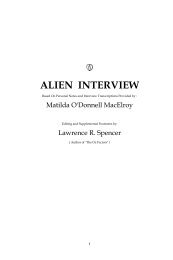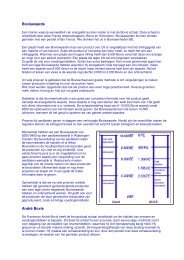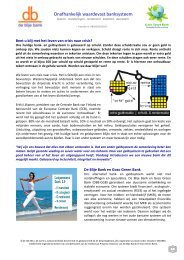De verborgen gevaren van vaccinaties - WantToKnow.nl
De verborgen gevaren van vaccinaties - WantToKnow.nl
De verborgen gevaren van vaccinaties - WantToKnow.nl
Create successful ePaper yourself
Turn your PDF publications into a flip-book with our unique Google optimized e-Paper software.
decided to undertake a study to determine whether immunization with the influenza vaccine<br />
with the MF59 adju<strong>van</strong>t stimulated antibody responses against squalen. To this end, we set up<br />
and validated an enzym-linked immunosorbent assay (ELISA), originally developed by<br />
Matyas et al., and tested serum samples from adults never immunized with vaccines with<br />
the MF59 adju<strong>van</strong>t and serum samples from individuals vacinated with the influenza<br />
vaccine with the MF59 adju<strong>van</strong>t.<br />
We conclude that antisqualene antibodies are found very frequently at low titers in sera from<br />
healthy, unvaccinated adults and that vaccination with influenza vaccine with the MF59<br />
adju<strong>van</strong>t does not result in any measurable impact on these antibody titers […]<br />
[…] Results<br />
Low titers of antisqualene antibodies are frequently detectable in the sera of healthy subjects.<br />
The first question we asked was wether or not IgM and IgG antibodies against squalene were<br />
present in serum samples of healthy adult individuals who had never received vaccines<br />
containing MF59 emulsion adju<strong>van</strong>t. To this end, we used the validated ELISA to test serum<br />
samples derived from adults from the United States and from western Europe. As shown in<br />
Table 1, serum antisqualene antibodies were very frequently detectable in healthy adults.<br />
Indeed, the frequency of IgG antibodies ranged from 26% found in the European cohort to<br />
79% found in the U.S. cohort; the frequency of IgM antibodies varied from 64% (European<br />
cohort) to 100% (U.S. cohort). In the eastern European cohort used to study the effects of<br />
vaccine with the MF59 adju<strong>van</strong>t (Table 2), 100% of sunjects were positive for antisqualene<br />
IgG at study entry, versus 52 to 58% positive for antisqualene IgM. Thus, prevalence of<br />
antisqualene antibodies may vary in different populations. As a matter of fact, for IgG, all<br />
pairwise comparisons among the three cohorts resulted in statistically significant differences,<br />
whereas for IgM o<strong>nl</strong>y differences between the U.S. and the two European cohorts were<br />
statistically significant. It does not appear that the frequency of antisqualene antibodies was<br />
linked to the age of the subjects, since the antibodies were found more frequently in the sera<br />
from the American cohort, which had an average age lower than that of th European cohorts.<br />
Table 1 also shows that the GMT of antisqualene IgG and IgM antibodies were consistently<br />
very low, ranging from 20 to 36 for IgG antibodies and from 31 to 51 for IgM antibodies<br />
(quantitation limits of 10 and 40, respectively).<br />
Itshould be added that when more than onde serum sample was available from the same<br />
subject, no trend towards an increase or a decrease of antisqualene antibody titers was<br />
evident (not shwon).<br />
Antisqualene antibody titers are not influenced by immunization with vaccines with the MF59<br />
adju<strong>van</strong>t. Having shown that antisqualene antibodies are found frequently in the sera of<br />
healthy adults, we asked whether immunization with vaccines with the MF59 emulsion<br />
adju<strong>van</strong>t (which contains squalene) would enhance antibody titers over time. To this end, we<br />
tested IgM and IgG antibodies in the sera of 48 individuals immunized with the influenza<br />
subunit vaccine with the MF59 adju<strong>van</strong>t and 52 individuals immunized with the control, split<br />
vaccine without adju<strong>van</strong>t. As shown in Fig. 1, prevaccination serum antisqualene IgG and<br />
IgM antibody titers were no affected by vaccination with influenza vaccine with the MF59<br />
adju<strong>van</strong>t either 1 month or 6 months after vaccination. In addition, the serum IgG and IgM<br />
antisqualene antibody titers for subjects immunized with the influenza vaccine with the MF59<br />
adju<strong>van</strong>t did not differ significantly from those measured for subjects immunized with the<br />
vaccine without adju<strong>van</strong>t at any time points studied (before, 1 month after, or 6 months after<br />
vaccination).<br />
As expected from the results obtained with the two younger cohorts, we also observed in a<br />
controlled clinical trial with elderly subjects that serum antisqualene IgG and IgM antibodies<br />
were extremely frequent before vaccination (52% to 58% for IgM and 100% for IgG).<br />
107







